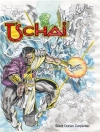Herland (1915) is a utopian novel by American author and feminist Charlotte Perkins Gilman. Herland was originally published in The Forerunner, a monthly magazine edited by Gilman, before going out of print for the next several decades. The novel was republished with an influential introduction by scholar Ann J. Lane in 1979 and has since been recognized as an important work of science fiction written by a leading feminist of the early twentieth century.
A sociologist and his two friends embark on an expedition to discover a rumored land where a lost civilization of women lives apart from the rest of the world. They journey by plane and, upon landing, are quickly captured by a group of women. Taken to town, the men are held in a central fortress where they are treated well and encouraged to learn more about the women’s culture in order to assimilate. They are taught the history of the land, which has been without men for two thousand years, and learn that the women are able to reproduce asexually. Although they recognize the utopian qualities of the society and despite being impressed by the beauty and order of its structures, the men struggle to live without presupposed notions of gender and patriarchy. When an escape attempt goes awry, they are forced to abandon their prejudices, joining the society through marriage. When one of the group fails to respect their hosts’ ideals of gender equality, however, the men are forced to make a decision that could endanger the continued existence of the utopia.
This edition of Charlotte Perkins Gilman’s Herland is a classic of American literature and science fiction reimagined for modern readers.
Since our inception in 2020, Mint Editions has kept sustainability and innovation at the forefront of our mission. Each and every Mint Edition title gets a fresh, professionally typeset manuscript and a dazzling new cover, all while maintaining the integrity of the original book.
With thousands of titles in our collection, we aim to spotlight diverse public domain works to help them find modern audiences. Mint Editions celebrates a breadth of literary works, curated from both canonical and overlooked classics from writers around the globe.
About the author
Charlotte Perkins Gilman (1860-1935) was an American author, feminist, and social reformer. Born in Hartford, Connecticut, Gilman was raised by her mother after her father abandoned his family to poverty. A single mother, Mary Perkins struggled to provide for her son and daughter, frequently enlisting the help of her estranged husband’s aunts, including Harriet Beecher Stowe, the author of Uncle Tom’s Cabin. These early experiences shaped Charlotte’s outlook on gender and society, inspiring numerous written works and a lifetime of activism. Gilman excelled in school as a youth and went on to study at the Rhode Island School of Design where, in 1879, she met a woman named Martha Luther. The two were involved romantically for the next few years until Luther married in 1881. Distraught, Gilman eventually married Charles Walter Stetson, a painter, in 1884, with whom she had one daughter. After Katharine’s birth, Gilman suffered an intense case of post-partum depression, an experience which inspired her landmark story “The Yellow Wallpaper” (1890). Gilman and Stetson divorced in 1894, after which Charlotte moved to California and became active in social reform. Gilman was a pioneer of the American feminist movement and an early advocate for women’s suffrage, divorce, and euthanasia. Her radical beliefs and controversial views on race—Gilman was known to support white supremacist ideologies—nearly consigned her work to history; at the time of her death none of her works remained in print. In the 1970s, however, the rise of second-wave feminism and its influence on literary scholarship revived her reputation, bringing her work back into publication.












